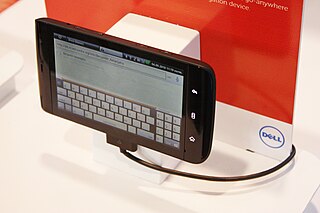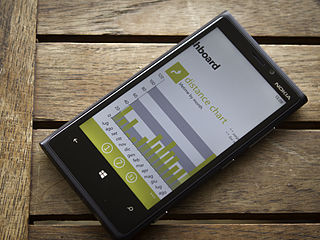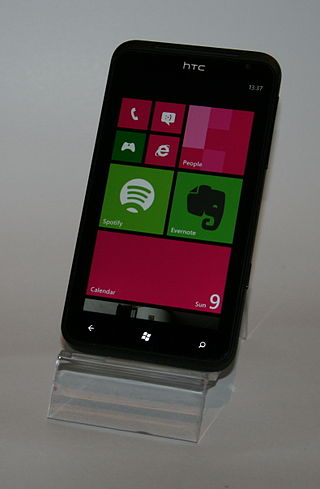
The Slingbox was a TV streaming media device made by Sling Media that encoded local video for transmission over the Internet to a remote device. It allowed users to remotely view and control their cable, satellite, or digital video recorder (DVR) system at home from a remote Internet-connected personal computer, smartphone, or tablet as if they were at home.

Zune was a brand of digital media products and services that was marketed by Microsoft from November 2006 until it was discontinued in June 2012. Zune consisted of a line of portable media players, a music subscription service known as Zune Music Pass plus Zune Marketplace for music, TV and movies, streaming services for the Xbox 360 game console, and the Zune software media player for Windows PCs which also acted as desktop sync software for Windows Phone.

Zune is a discontinued software program that was developed by Microsoft for Windows that functions as a full media player, library, media streaming server, mobile device management, and interface for the discontinued Zune Marketplace. The software is used to sync with all devices with Zune functionality including the Zune 4, 8, 16, 30, 80, 120, Zune HD, Windows Phone 7, and Microsoft Kin. Zune devices work exclusively with the Zune software, which applies many design principles of Microsoft's Metro design language.

BenQ Corporation is a Taiwanese multinational company that sells and markets technology products, consumer electronics, computing and communications devices under the "BenQ" brand name, which stands for the company slogan Bringing Enjoyment NQuality to life. Its principal products include Televisions, LCD monitors, projectors, interactive displays, speakers, lighting, peripherals, and mobile computing devices.

Windows Phone (WP) is a discontinued mobile operating system developed by Microsoft for smartphones as the replacement successor to Windows Mobile and Zune. Windows Phone featured a new user interface derived from the Metro design language. Unlike Windows Mobile, it was primarily aimed at the consumer market rather than the enterprise market.

Kin was a short-lived mobile phone line from Microsoft designed for users of social networking. The phones, aimed at people between ages 15 and 30, were manufactured by Sharp Corporation and sold through Verizon Wireless.

Samsung Galaxy is a series of computing and mobile computing devices that are designed, manufactured and marketed by Samsung Electronics. The product line includes the Samsung Samsung Galaxy S series of high-end phones, Samsung Galaxy Z series of high-end foldables, Samsung Galaxy A series of Mid-range phones, the Samsung Galaxy Book, the Samsung Samsung Galaxy Tab series, the Samsung Galaxy Watch, the Samsung Samsung Galaxy Buds series and the Samsung Samsung Galaxy Fit.
The Omnia series is a line of smartphones produced by Samsung Electronics. Omnia devices run either Microsoft's Windows Mobile 6.5, or Windows Phone 7 operating systems, and one Symbian device under the brand was also released.

The Dell Streak 5 is a smartphone/tablet hybrid ("phablet") from Dell that uses the Android operating system, released in 2010. It comes with a 5-inch (13 cm) capacitive touchscreen and two cameras, a 5MP one with dual-LED flash on the back and a VGA-resolution one on the front for video calling; both are capable of video.
The Dell Venue is a line of Android smartphones and tablets manufactured by Dell. The first Dell Venue was released for both T-Mobile and AT&T in the United States, and for KT in South Korea. It was the second Dell smartphone to be released in the US and features the Dell Stage UI also found on the Dell Streak line of tablets. As of 2011, it was the only Android device the United States Department of Defense has approved for its employees use. Since then, there have been other approved devices.

The HTC 7 Surround is a smartphone created by HTC running on the Windows Phone 7 operating system. The HTC Surround launched on November 8, 2010 on AT&T.
This page provides details for the version history of the Microsoft's Windows Phone branded mobile operating systems, from the release of Windows Phone 7 in October 2010, which was preceded by Windows Mobile version 6.x.

The Nokia N9 is a flagship smartphone developed by Nokia, running on the Linux-based MeeGo mobile operating system. Announced in June 2011 and released in September, it was the first and only device from Nokia with MeeGo, partly because of the company's partnership with Microsoft announced that year. It was initially released in three colors: black, cyan and magenta, before a white version was announced at Nokia World 2011.

The BlackBerry Bold 9700 is a smartphone developed by telecommunication company BlackBerry, formerly known as Research in Motion (RIM). The second device in the Bold series, it succeeds the model 9000 and precedes the Bold 9650. The device, which runs on the BlackBerry OS, features several improvements over the 9000, including introduction of an optical trackpad, and a reduced size overall. Other visual changes were carried out in order to appeal both men and women.
Microsoft mobile services are a set of proprietary mobile services created specifically for mobile devices; they are typically offered through mobile applications and mobile browser for Windows Phone platforms, BREW, and Java. Microsoft's mobile services are typically connected with a Microsoft account and often come preinstalled on Microsoft's own mobile operating systems while they are offered via various means for other platforms. Microsoft started to develop for mobile computing platforms with the launch of Windows CE in 1996 and later added Microsoft's Pocket Office suite to their Handheld PC line of PDAs in April 2000. From December 2014 to June 2015, Microsoft made a number of corporate acquisitions, buying several of the top applications listed in Google Play and the App Store including Acompli, Sunrise Calendar, Datazen, Wunderlist, Echo Notification Lockscreen, and MileIQ.

Nokia Lumia 920 is a smartphone developed by Nokia that runs the Windows Phone 8 operating system. It was announced on September 5, 2012, and was first released on November 2, 2012. It has a 1.5 GHz dual-core Qualcomm Krait CPU and a 4.5" IPS TFT LCD display, as well as a high-sensitivity capacitive touchscreen that can be used with gloves and fingernails; the display is covered by curved Gorilla Glass and has a 9 ms response time. The phone features an 8.7-megapixel PureView camera with OIS; it was the first smartphone camera to implement that technology, as well as to support Qi inductive charging. The phone comes with 32 GB of internal storage, but has no expandable storage.

Windows Phone 7 is the first release of the Windows Phone mobile client operating system, released worldwide on October 21, 2010, and in the United States on November 8, 2010. It runs on the Windows CE 6.0 kernel.
The Nokia Lumia 822 is a smartphone running Windows Phone 8 announced on 29 October 2012. It is exclusively available for Verizon customers. The device is a variant of Nokia Lumia 820. The Lumia 822 supports Qi standard induction charging and LTE connectivity.
Google Fi Wireless, formerly Project Fi and Google Fi, is an American MVNO telecommunications service by Google that provides telephone calls, SMS, and mobile broadband using cellular networks and Wi-Fi. Google Fi uses the T-Mobile network. Google Fi is a service for US residents only, as of late 2023.












